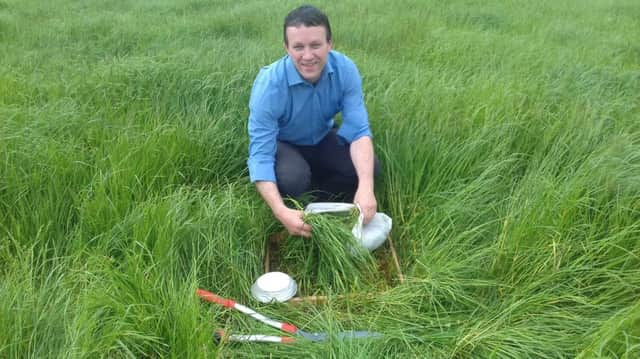How much silage are you actually making this year?


“Swards, particularly in the west, are now at an optimal growth stage,” he said.
“In addition, grass nitrogen levels are at sufficiently low levels so as not to be a hindrance to fermentation. It all adds up to a unique opportunity for farmers to make extremely high quality forage.
Advertisement
Advertisement
“It should also be pointed out that the use of a proven inoculant, such as Provita’s Advance+, represents the icing on the cake, where forage quality is concerned.”
But Mr Armstrong (pictured) is very conscious of the need to apply an additive at the most efficient rate possible.
“To do this, it is important to estimate the amount of fresh grass that will be ensiled. This can be assessed very easily by simply weighing the actual quantity of grass cut from a half metre by half meter quadrat.
“It is important to cut the grass to mower height. Once the grass has been weighed in kilos it is simply a case of multiplying this figure by 40,000 to get to an output per hectare figure.
Advertisement
Advertisement
“For example, if the cut grass weight is 0.6kg, this translates to a total fresh forage output per hectare of 24 tonne. By dividing this figure by 2.4, one arrives at an output per acre figure.”
Armstrong also pointed out that grassland yields can vary by up to 50% across an average field.
He continued: “Silage additive should be applied accurately so that it works but not higher than it needs to be as this wastes money.
“When doing farm trials this year, I wanted to be very accurate in application of our silage inoculant Advance+.
Advertisement
Advertisement
“When I was researching a method to do this I looked at the calculation used for usable grass dry matters per hectare. I figured out that the same method can be used.
“Assessing grass freshweights is a very straightforward process. And I would encourage all farmers to look at this option at silage-making time.”
The Provita representative said that an accurate estimation of the grass tonnages to be harvested will allow farmers and contractors to accurately estimate the amount of inoculant they will need.
“An application rate pf 400g of inoculant per tonne is the norm,” he said.
Advertisement
Advertisement
“So there is also an absolute need to ensure that the inoculant applicator is calibrated accordingly.”
According to Mr Armstrong, the output from applicator on the harvester should be measured for one minute.
“A representative load of grass should be then timed and ideally weighed. This will then give the harvester tonnes-per-minute rate. For trailed harvesters, this averages around 1 tonne per minute. But this will be different for each machine.”
Armstrong confirmed the benefits of Advance +, both in terms of helping to make high quality silage and maximising forage availability at feed out.
Advertisement
Advertisement
“The inoculant has been specifically formulated to provide maximum effect with the grasses grown in Northern Ireland and our unpredictable climate.
“It will act to ensure that forage quality is maximised in the clamp and, furthermore, that optimal stability levels are secured once the forage is exposed to the air.
“Large number of farmers across Northern Ireland have found that Advance + will act to ensure almost zero losses of forage within a clamp.
“But, obviously, all other aspects of clamp management must be up to the required standard throughout the entire silage making process.”
For further information, call Provita on 02882252352 or ring 07720101444.